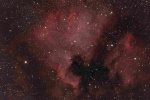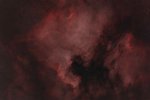I've had some very nice success using the new starnet++ program to remove stars from a stretched image. The following has worked for me"
I downloaded Starnet++ from the link below which was provided by Geethq.
https://sourceforge.net/projects/starnet/
I found the following works for Windows computers:
1) After downloading, the starnet++ files will be located in a folder named starnet. Don't forget to extract the files.
2) The program only works on 16 bit unsigned .tif files.
3) Save the file you wish to remove the stars from into the starnet folder (for example, FlamingStar.tif) in 16 bit unsigned format.
4) Open the Command Prompt.
- I typed capital C in the search box in the lower left corner of the Windows 10 home screen.
- In the popup window click on Command Prompt.
- In Command Prompt type cd\the path to the starnet folder\starnet (e.g., cd\Documents\starnet ) then hit enter.
- Type starnet++ OriginalFileName.tif StarlessFileName.tif where OriginalFileName is the name of the file you want to process.
EXAMPLE: starnet++ myimage.tif mystarlessimage.tif (notice that there are spaces between starnet++, myimage.tif, and mystarlessimage.tif.
- Once the filenames are typed in hit ENTER and wait till the processing is completer. Progress is shown as %done.
When the Command Prompt says Done, the resulting starless image will be located in the starnet folder.
Attached are examples showing an original image and the starless version produced by starnet++.
Using PixInsight, I typically do sharpening (MLT), contrast enhancement (LHE), color saturation boosting with CurvesTransformation, and noise reduction (TGV) on the starless image. Your processing software and enhancement choices may be different.
Once the starless image is "enhanced" I use PixelMath to combine the starless and original image with the simple expression
max(original, starless)
Hope this makes sense.
Steve
I downloaded Starnet++ from the link below which was provided by Geethq.
https://sourceforge.net/projects/starnet/
I found the following works for Windows computers:
1) After downloading, the starnet++ files will be located in a folder named starnet. Don't forget to extract the files.
2) The program only works on 16 bit unsigned .tif files.
3) Save the file you wish to remove the stars from into the starnet folder (for example, FlamingStar.tif) in 16 bit unsigned format.
4) Open the Command Prompt.
- I typed capital C in the search box in the lower left corner of the Windows 10 home screen.
- In the popup window click on Command Prompt.
- In Command Prompt type cd\the path to the starnet folder\starnet (e.g., cd\Documents\starnet ) then hit enter.
- Type starnet++ OriginalFileName.tif StarlessFileName.tif where OriginalFileName is the name of the file you want to process.
EXAMPLE: starnet++ myimage.tif mystarlessimage.tif (notice that there are spaces between starnet++, myimage.tif, and mystarlessimage.tif.
- Once the filenames are typed in hit ENTER and wait till the processing is completer. Progress is shown as %done.
When the Command Prompt says Done, the resulting starless image will be located in the starnet folder.
Attached are examples showing an original image and the starless version produced by starnet++.
Using PixInsight, I typically do sharpening (MLT), contrast enhancement (LHE), color saturation boosting with CurvesTransformation, and noise reduction (TGV) on the starless image. Your processing software and enhancement choices may be different.
Once the starless image is "enhanced" I use PixelMath to combine the starless and original image with the simple expression
max(original, starless)
Hope this makes sense.
Steve


